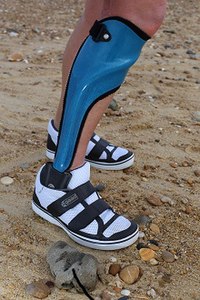
Photo from wikipedia
BACKGROUND Foot orthoses are commonly used to correct for foot alterations and especially address excessive foot pronation in individuals with flatfeet. In recent years, 3D printing has taken a key… Click to show full abstract
BACKGROUND Foot orthoses are commonly used to correct for foot alterations and especially address excessive foot pronation in individuals with flatfeet. In recent years, 3D printing has taken a key place in orthotic manufacturing processes as it offers more options and can be patient specific. Hence, the purpose of this study was to evaluate whether stiffness of 3D printed foot orthoses and a newly designed rearfoot posting have an effect on lower limb kinematics and kinetics in individuals with flatfeet. METHODS Nineteen patients with flexible flatfeet were provided two pairs of customized 3D printed ¾ length orthotics. Foot orthoses were of different stiffness and could feature a rearfoot posting, consisting of 2-mm carbon fiber plate. Lower limb kinematics and kinetics were computed using a multi-segment foot model. One-way ANOVAs using statistical non-parametric mapping, refined by effect sizes, were performed to determine the magnitude of the effect between conditions. FINDINGS Foot orthoses stiffness had little effect on midfoot and forefoot biomechanics. Reductions in midfoot eversion and forefoot abduction were observed during short periods of stance with rigid foot orthoses. Adding the posting had notable effects on rearfoot kinematics and on the ankle and knee kinetics in the frontal plane; it significantly reduced the eversion angle and inversion moment at the ankle, and increased the knee abduction moment. INTERPRETATION Using an anti-pronator component is more effective than increasing foot orthoses stiffness to observe a beneficial impact of foot orthoses on the control of excessive foot pronation in individuals with flatfeet.
Journal Title: Clinical biomechanics
Year Published: 2021
Link to full text (if available)
Share on Social Media: Sign Up to like & get
recommendations!